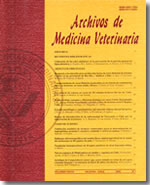Infectious Bursal Disease Virus: antigenic interrelationships between
Main Article Content
Abstract
Infectious Bursal Disease (IBD) is still affecting the poultry industry through the appearance of pathogenic and antigenic variations of the virus. This is due to its permanent evolution as a consequence of the immunological pressure caused by the intensive use of vaccines. The antigenic characterization of field viruses is essential in order to use the most appropriate vaccines to control the disease. The purpose of this study was to determine the antigenic interrelationship between cuban and chilean isolates obtained from flocks vaccinated with the IBD virus. Viral isolates were adapted to cell culture and mono-specific antisera were obtained for each isolate and for a reference strain. The interrelationship between the isolates were established by cross virus neutralization using nine cuban isolates (BD, BL, 35/95, 29/96, 118/96, BF2, BF8, BF9, y 70/98), three chilean isolates (G1, G2, y G4) and a reference strain from serotype 1 (Lukert). Both types of isolates adapted efficiently to chicken embryo fibroblast cultures. In addition, cuban isolates adapted to VERO cells and showed higher infective titers in chicken embryo fibroblasts than in this cell line. Cross virus neutralization results showed an interrelationship greater than 80% amongst cuban isolates and greater than 70% between the isolates and the reference strain. Chilean isolates G1 and G4 showed a similar result (higher than 77%). The G2 isolate had lower antigenic differences from cuban isolates BL 35/95 y 29/96 ( 69%). None of the isolates showed antigenic interrelationships lower than 30% with the serotype 1 reference strain and consequently, they do not correspond to variant strains.

